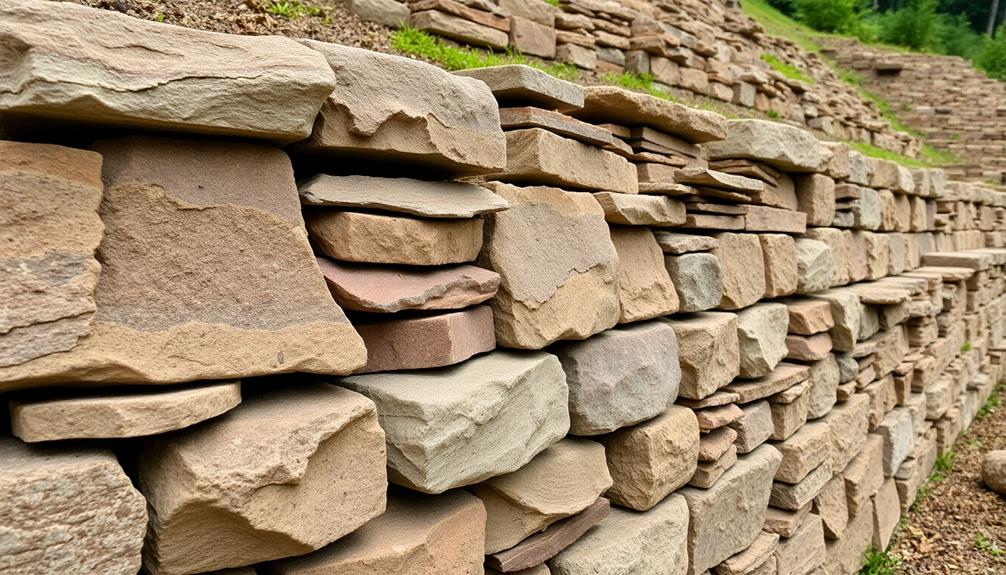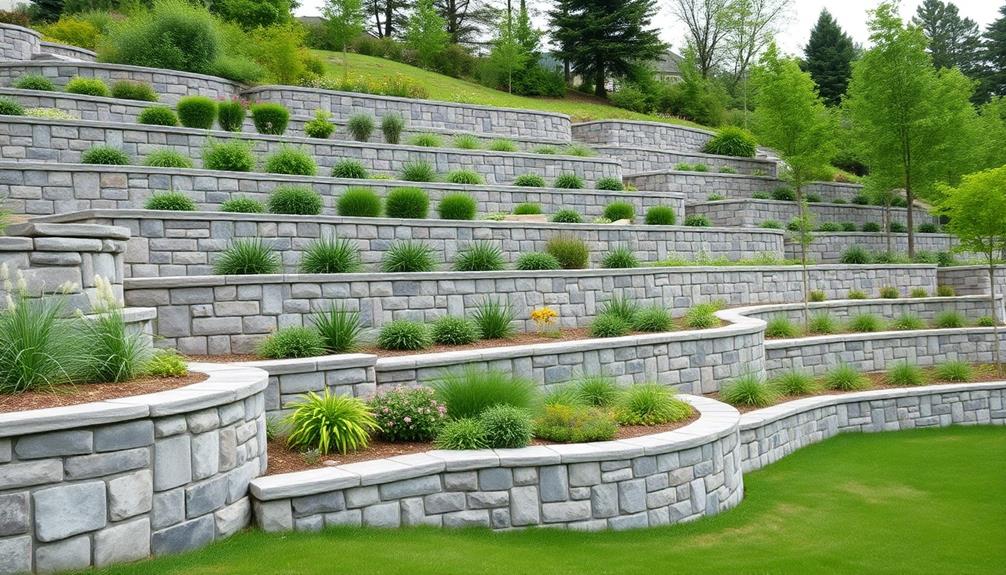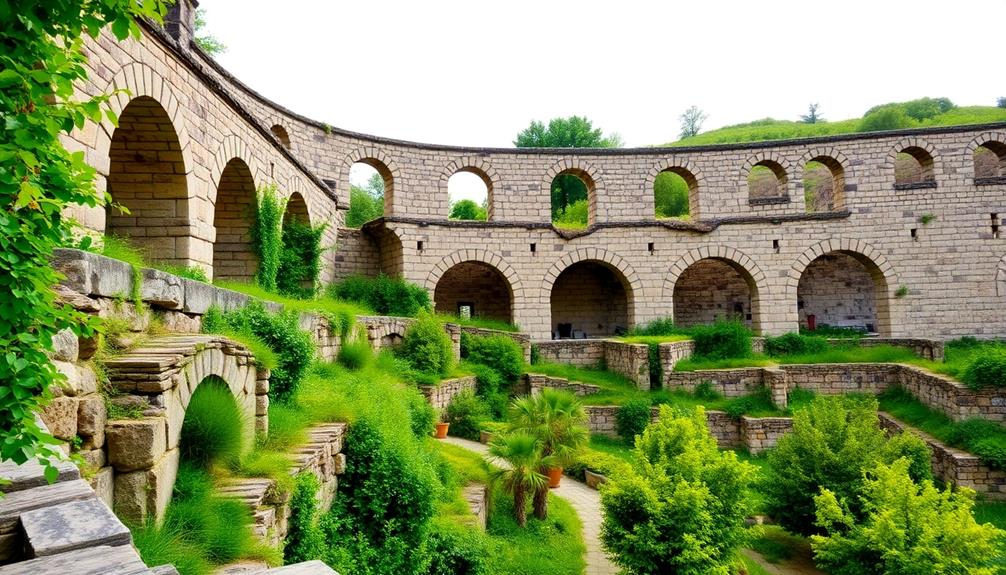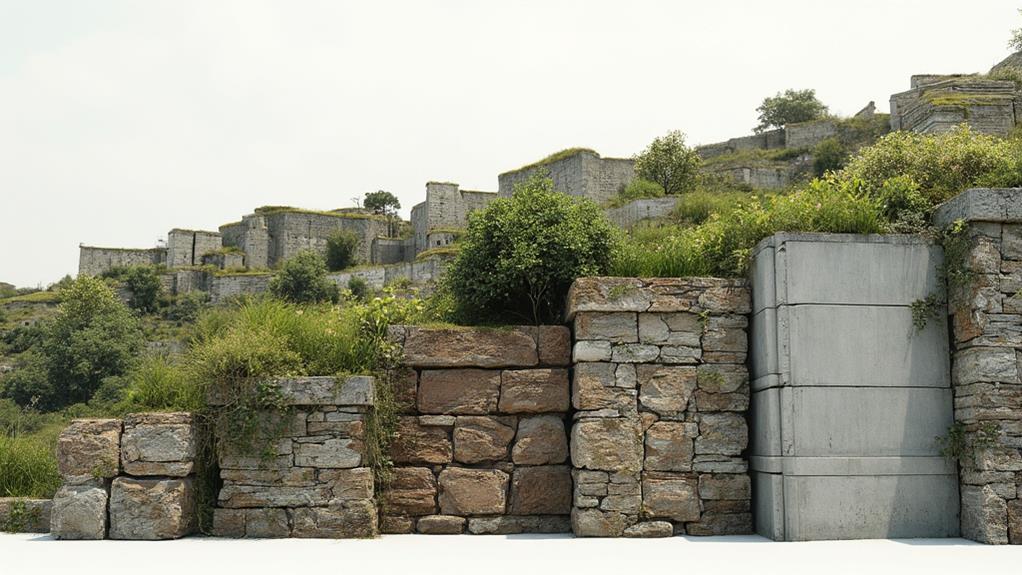The history of retaining wall design and construction reflects an evolution from primitive stone and timber solutions to sophisticated modern structures utilizing advanced materials and engineering techniques. Originally, basic dry-stacked and mortared stone walls provided essential earth retention. As technology advanced, concrete and reinforced concrete became prominent for their durability and strength, leading to modern methods such as segmental systems and geosynthetic reinforcements. Design principles evolved with a focus on stability, drainage, and soil mechanics, influenced by ancient Roman engineering, which introduced techniques like opus caementicium. Current practices emphasize both aesthetic and functional integration within varied environments and terrains, promising further insights.
Table of Contents
ToggleWalls Contractor Highlights
- Early retaining walls utilized stone and timber, evolving from dry-stacked to mortared stone for improved structural integrity.
- The introduction of concrete and reinforced systems advanced retaining wall load-bearing capabilities and versatility.
- Roman techniques, like opus caementicium and stone masonry, significantly influenced modern retaining wall construction methods.
- Modern retaining walls incorporate geosynthetics and drainage systems for enhanced stability and environmental harmony.
- Retaining walls serve diverse applications, enhancing landscapes, preventing erosion, and increasing property value through functional design.
Definition of Retaining Walls

Retaining walls serve a critical purpose in landscape and civil engineering by providing essential support to vertical or near-vertical grade changes, thereby preventing soil erosion and managing water drainage effectively. These structures are commonly constructed using materials such as concrete, stone, and timber, each chosen for its durability and suitability to the specific environmental conditions.
In the Twin Cities area, materials like limestone, boulders, and granite are often utilized for their structural advantages and aesthetic appeal. The design principles underlying retaining walls involve careful consideration of factors such as soil characteristics, load-bearing capacity, and the intended lifespan of the wall, ensuring both stability and longevity in their application.
Purpose and Functionality Overview
In civil engineering and landscape architecture, retaining walls serve a critical role by providing lateral support to vertical or near-vertical slopes of soil. These structures are meticulously engineered to withstand the lateral pressure exerted by soil, water, or other materials, ensuring stability and preventing erosion or collapse. Their primary purpose is to enable the construction of structures on terrains that would otherwise be unsuitable due to their natural slope, thereby expanding the possibilities for development in diverse environments.
Retaining walls are instrumental in managing landscapes, where they facilitate the creation of level areas for roads, railways, and building foundations. They are essential in preventing soil erosion on steep gradients and safeguarding infrastructure by redirecting water flow, consequently mitigating the risk of flooding.
In urban settings, retaining walls contribute to maximizing usable space by creating terraced landscapes, which are not only functional but also aesthetically pleasing.
Moreover, the functionality of retaining walls extends to enhancing the safety and longevity of built environments. By withstanding environmental pressures and resisting the forces of nature, they provide a sense of security and belonging to communities, allowing for sustainable and harmonious development in tandem with natural landscapes.
Common Materials Utilized
A diverse array of materials is employed in the construction of retaining walls, each selected based on specific engineering requirements and aesthetic considerations. Historically, stone has been a prevalent choice, lauded for its natural beauty and strength, seamlessly integrating with landscapes while providing enduring stability. Mortared stone walls offer enhanced structural integrity compared to their dry-stacked counterparts, which rely on precise craftsmanship and gravity for cohesion.
Concrete has emerged as a dominant material due to its versatility and adaptability, capable of being cast into various forms and textures, allowing for bespoke designs that cater to both modern and traditional aesthetics. Reinforced concrete, often augmented with steel rebar, presents a formidable option for retaining walls, combining tensile strength with durability, suitable for supporting significant loads. Segmental retaining walls, composed of interlocking concrete blocks, provide modular solutions that facilitate ease of installation and flexibility in design.
Timber, although less durable than stone or concrete, is favored for its rustic charm and cost-effectiveness, commonly used in residential applications where lower heights are required. Additionally, gabion walls, constructed from wire cages filled with rocks or rubble, offer an eco-friendly alternative that integrates well with natural surroundings while ensuring effective erosion control.
Structural Design Principles
Fundamental to understanding retaining walls is the concept of stability, which underpins their structural design principles. Retaining walls serve the essential function of holding back soil, maintaining differences in elevation, and preventing erosion, all while assuring safety and durability. The stability of these structures is achieved through careful consideration of various forces and earth pressures acting upon the wall.
Key principles include ensuring adequate resistance to sliding, overturning, and bearing capacity failures. This requires an extensive understanding of soil mechanics, wall construction materials, and the surrounding environmental conditions.
To convey the intricacies of retaining wall design, consider the following elements that contribute to their stability:
- Gravity: The wall's mass counteracts the lateral earth pressures.
- Reinforcement: Steel or geosynthetics enhance the wall's tensile strength.
- Drainage: Proper drainage systems reduce hydrostatic pressure and prevent water accumulation.
- Footings: Foundation design ensures load distribution and enhances wall stability.
For those involved in retaining wall construction, a solid grasp of these principles fosters a sense of belonging within the engineering community. It enables collaboration between architects, engineers, and builders, each contributing their expertise to create structures that stand the test of time. This shared knowledge and purpose unite professionals in their pursuit of excellence in design and construction.
Benefits

Retaining walls offer a multitude of benefits, primarily by enhancing erosion control efficiency, which safeguards landscapes against soil displacement and potential damages. Additionally, they provide significant structural stability advantages, contributing to the long-term integrity of both natural and built environments.
Retaining walls, such as boulder walls, make a powerful statement with their size, offering a natural, one-of-a-kind appearance and requiring specialized installation expertise. They also serve as aesthetically pleasing landscape features that can elevate the visual appeal of a property. Moreover, the integration of well-designed retaining walls can lead to an increase in property value, as they combine functional necessity with attractive design elements.
Erosion Control Efficiency
Erosion control efficiency stands as a pivotal benefit of well-designed retaining walls, substantially impacting both environmental preservation and structural integrity. These structures act as formidable barriers against soil displacement, ensuring landscapes remain intact and productive.
Retaining walls provide a crucial line of defense against the pervasive threat of erosion, protecting ecosystems and human endeavors alike. By maintaining soil stability, they foster an environment where vegetation can thrive, reducing the risk of landslides and sediment runoff into nearby water bodies.
Consider the following benefits of erosion control efficiency through retaining walls:
- Preservation of Topsoil: By preventing soil erosion, retaining walls help maintain the nutrient-rich top layer of soil, essential for agricultural productivity and biodiversity.
- Protection of Water Quality: Reduced sediment runoff safeguards water bodies from pollution, ensuring clean water sources for communities and wildlife.
- Enhanced Vegetative Growth: Retaining walls create stable conditions for plant life, promoting root establishment and improving overall ecological health.
- Aesthetic and Functional Landscapes: Beyond functionality, these structures contribute to visually pleasing and usable terrains, aligning with community values and aesthetic desires.
Incorporating these walls into landscape design is a hallmark of the harmonious balance between human needs and environmental stewardship, fostering a sense of belonging within the natural world.
Structural Stability Advantages
Building on the erosion control efficiency discussed earlier, the structural stability advantages of retaining walls further underscore their importance in landscape design and construction. Retaining walls are engineered to withstand lateral earth pressure, providing essential support for terrain that would otherwise succumb to gravity.
This structural integrity is vital in preventing landslides, soil erosion, and flooding, ensuring a safe and secure living environment for communities that thrive in diverse topographies.
The robust construction of retaining walls often involves materials such as concrete, stone, or timber, each selected for its durability and compatibility with the surrounding environment. These materials are meticulously arranged to form barriers that not only stabilize the earth but also accommodate the natural expansion and contraction of soil.
This adaptability is indispensable in areas prone to seismic activity or significant weather fluctuations, where the force of moving earth can pose a substantial risk. Moreover, retaining walls contribute to the longevity of adjacent structures, such as roads and buildings, by maintaining the integrity of the surrounding land. Their presence minimizes the shifting of soil, thereby reducing potential damage and maintenance costs. Accordingly, retaining walls are indispensable in fostering a harmonious balance between human development and natural landscapes.
Aesthetic Landscape Enhancement
In addition to their functional benefits, retaining walls considerably enhance the aesthetic appeal of landscapes. They serve as a canvas for creativity, transforming ordinary terrains into visually mesmerizing spaces. With an array of materials, colors, and textures available, retaining walls can be customized to seamlessly integrate into the landscape's natural beauty, creating a harmonious environment that fosters a sense of belonging. These structures are more than just functional; they are an art form that can define and elevate the character of an outdoor space.
Terraced Gardens: Retaining walls enable the creation of terraced gardens that add depth and dimension, allowing for a diverse range of plantings to thrive at different levels.
Natural Stone Elegance: The use of natural stones can imbue landscapes with timeless elegance, reflecting the inherent beauty of the earth's materials.
Seating and Gathering Spaces: Designed with built-in seating, retaining walls can transform into inviting gathering spaces, fostering community interaction and family togetherness.
Lighting Integration: By incorporating lighting elements, retaining walls can illuminate pathways and highlight architectural features, enhancing both safety and ambiance.
These aesthetic enhancements marry functionality with design, creating landscapes that are both beautiful and purposeful, fostering a true sense of community pride and personal satisfaction.
Property Value Increase
Retaining walls can remarkably enhance property value by optimizing land use and improving curb appeal. These structures not only address the practicalities of erosion control and landscape management but also contribute significantly to the visual and functional appeal of a property.
By transforming uneven terrain into usable spaces, retaining walls allow for the creation of terraces, gardens, or additional flat areas, effectively increasing the usable square footage of the land. This transformation can attract potential buyers or renters who are often willing to invest more in properties that maximize space and aesthetic potential.
Moreover, retaining walls can be tailored to complement the architectural style of a home or neighborhood, blending seamlessly with existing elements to enhance the overall visual harmony. This customization, often achieved through the selection of materials, colors, and design, can make a property stand out in the real estate market. Potential buyers are likely to perceive such enhancements as valuable, often translating into higher offers or quicker sales.
In other words, the strategic implementation of retaining walls not only fulfills functional needs but also plays a pivotal role in elevating both the marketability and perceived worth of a property.
Ancient Roman Techniques

The ingenuity of ancient Roman engineering is exemplified in their retaining wall techniques, which integrated advanced materials and construction methods that have profoundly influenced modern designs. Through the use of innovations such as opus caementicium (Roman concrete) and precise stone masonry, the Romans achieved structural stability and durability that remain unparalleled in many aspects. These foundational techniques continue to inform contemporary practices, as evidenced by the adoption of similar strategies in today's retaining wall constructions.
| Roman Techniques | Modern Influence |
|---|---|
| Opus Caementicium | Concrete technology |
| Stone Masonry | Aesthetic design |
| Structural Stability | Engineering principles |
| Durability | Longevity in construction |
| Architectural Innovation | Modern adaptation |
Roman Engineering Innovations
Stepping into the domain of ancient engineering marvels, Roman innovations in retaining wall design stand as a tribute to their advanced understanding of construction techniques. The Romans were renowned for their architectural prowess, employing methods that not only served functional purposes but also embodied aesthetic excellence. Their retaining walls were not mere constructions but rather symbols of their commitment to durability and precision. These walls were integral in supporting the sprawling infrastructure of the Roman Empire, from aqueducts to roadways, showcasing an unparalleled engineering genius.
Roman engineers utilized a variety of techniques to guarantee the stability and longevity of these structures. Key innovations included:
- Strategic use of gravity and pressure: The Romans understood the importance of leveraging gravitational forces to enhance wall stability.
- Incorporation of drainage systems: Effective drainage reduced hydrostatic pressure, preventing structural damage.
- Sophisticated geometric designs: They employed precise angles and shapes to optimize load distribution.
- Integration with surrounding landscapes: Roman walls were often seamlessly blended into natural terrains, enhancing both strength and aesthetic appeal.
Through these innovations, Roman retaining walls not only fulfilled their primary purpose but also left an indelible legacy, influencing modern engineering practices and fostering a sense of belonging within the vast Roman Empire.
Materials and Construction Methods
Among the many factors contributing to the enduring legacy of Roman retaining walls, the choice of materials and construction methods was paramount. Romans exhibited an advanced understanding of materials, skillfully employing locally-sourced stone and the revolutionary invention of Roman concrete, or opus caementicium. This innovative material, composed of lime mortar, volcanic ash, water, and aggregates, possessed remarkable durability, enabling structures to withstand the test of time. Romans meticulously selected and processed these components, creating robust walls that provided both stability and resilience.
Construction methods employed by the Romans reflected a harmonious blend of practicality and ingenuity. The walls often began with a core of opus caementicium, enveloped by meticulously cut stone blocks, which were frequently set without mortar, demonstrating a profound grasp of dry stone walling techniques. This dual-layer approach not only fortified the structure but also allowed for efficient water drainage, vital for maintaining the wall's integrity. The implementation of arches and vaults within retaining walls further showcased Roman mastery, distributing weight evenly and enhancing structural strength.
In essence, the Romans' strategic use of superior materials and sophisticated construction techniques guaranteed their retaining walls were not only functional but also emblematic of their architectural prowess, fostering a sense of belonging and continuity.
Influence on Modern Designs
Building upon the Romans' mastery of materials and construction methods, modern retaining wall designs continue to echo the ingenuity of ancient techniques. The Romans' pioneering use of concrete, with its durable properties, laid the foundation for contemporary practices. Their opus caementicium, a precursor to modern concrete, combined lime mortar with volcanic ash, producing a formidable and long-lasting material.
This ancient innovation inspires current engineers to create robust, environmentally resilient structures. By understanding the Romans' approach to site-specific designs, today's builders can adapt to diverse landscapes and challenging terrains, ensuring structural integrity and aesthetic harmony.
Modern retaining walls, influenced by Roman techniques, often incorporate:
- Gravity Walls: Utilizing mass and weight to resist lateral earth pressure, echoing the Romans' emphasis on solid construction.
- Cantilever Walls: Employing vertical structures with base slabs for stability, reminiscent of Roman arch principles.
- Segmental Retaining Walls: Modular units that reflect the Romans' adaptability in construction techniques.
- Geosynthetic Reinforced Walls: Advanced materials providing strength and flexibility, inspired by the Romans' innovative material use.
Incorporating these elements fosters a sense of connection to the enduring craftsmanship of the past, allowing modern communities to build with confidence and respect for historical ingenuity.
Walls Contractor FAQ
How Have Modern Construction Materials Impacted Retaining Wall Design?
Modern construction materials have revolutionized retaining wall design by enhancing structural integrity, reducing costs, and increasing sustainability. These advancements foster a sense of community among professionals committed to innovative, durable, and environmentally responsible construction practices.
What Role Do Retaining Walls Play in Urban Infrastructure?
Retaining walls are integral to urban infrastructure, providing essential support for landscape management, preventing soil erosion, and enhancing stability. They foster a sense of safety and community by ensuring the durability and functionality of urban environments.
How Has Technology Improved Retaining Wall Construction Methods?
Technological advancements, including geosynthetic materials and computer-aided design, have enhanced retaining wall construction by improving durability, efficiency, and cost-effectiveness. These innovations foster reliable infrastructure, ensuring safety and sustainability, thereby strengthening community connections and resilience in urban environments.
What Are Common Challenges Faced in Retaining Wall Maintenance?
Retaining wall maintenance often faces challenges such as drainage issues, soil erosion, and structural degradation. Addressing these requires regular inspections, effective water management, and timely repairs, fostering a sense of community safety and ensuring long-term stability for shared spaces.
How Do Environmental Factors Influence Retaining Wall Longevity?
Environmental factors greatly impact retaining wall longevity by affecting material degradation, erosion, and structural integrity. Factors such as soil moisture, freeze-thaw cycles, and vegetation growth can accelerate deterioration, necessitating community-focused maintenance strategies to uphold safety and sustainability over time.







